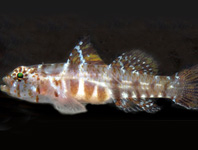Abstract
We describe a new species of Leiocephalus from the coastal dunes of Bahía de las Calderas in the southwestern Dominican Republic. In external morphology, Leiocephalus sixtoi sp. nov. is most similar to L. schreibersii and L. inaguae. Leiocephalus sixtoi differs from L. inaguae in having a U-shaped bony parietal table (vs. V-shaped in L. inaguae), 3 or 4 enlarged postcloacal scales in males (vs. 2 in L. inaguae), most scales on snout posterior to internasal scales rugose to keeled scales (vs. smooth in L. inaguae), and a patternless throat in males, spots on the throat in females (vs. throat with dark streaks and bars in males and females of L. inaguae). Leiocephalus sixtoi differs from L. schreibersii in having the scales of the lateral fold only slightly smaller than adjacent scales (vs. scales of lateral fold distinctly smaller than adjacent scales), having prominent caudal crest scales in adult males (vs. caudal crest scales of moderate size, even in very large males in L. schreibersii), a pattern of dark gray bars on a grayish brown background in the region above the lateral body fold (vs. dense turquoise blue mottling with heavy suffusion of red pigment in L. schreibersii), a darker dorsal ground color (vs. paler in L. schreibersii), and a red iris in adult males (vs. pale grayish blue in adult male L. schreibersii). Leiocephalus sixtoi differs further from L. schreibersii in several osteological characters as follows: in L. sixtoi the nasal process of the premaxilla reaches to mid-level of the bony external nares (vs. to level of posterior margin of the bony external nares in L. schreibersii), lacking a constriction at the base of the nasal process of the premaxilla (vs. such a constriction present in L. schreibersii), and having a reduced nasal-prefrontal contact leaving the nasal processes of the frontal bone exposed (vs. nasal and prefrontal bones contact one another, thereby obscuring the nasal processes of the frontal bone in L. schreibersii). We designate SMF 26228, an adult male from Saint Marc, Province Artibonite, Haiti, as the neotype of L. schreibersii.
References
Anonymous (2016) Dunas de Baní. Available from: https://es.wikipedia.org/wiki/Dunas_de_ Baní (accessed 28 April 2016)
Cochran, D.M. (1931) New Bahaman reptiles. Journal of the Washington Academy of Sciences, 21, 39–40.
Cope, E.D. (1863) Contributions to Neotropical saurology. Proceedings of the Academy of Natural Sciences of Philadelphia, 14, 176–188. [1862]
Cope, E.D. (1868) An examination of the Reptilia and Batrachia obtained by the Orton Expedition to Equador and the Upper Amazon, with notes on other species. Proceedings of the Academy of Natural Sciences of Philadelphia, 20, 96–140.
Duméril, A.M.C. & Bibron, G. (1837) Erpétologie Générale ou Histoire Naturelle Complete des Reptiles. Vol. 4. Libr. Encyclopédique Roret, Paris, 570 pp.
Etheridge, R. (1964) Late Pleistocene lizards from Barbuda, British West Indies. Bulletin of the Florida State Museum, 9, 43–75.
Gravenhorst, J.L.C. (1838) Beiträge zur genaueren Kenntniss einiger Eidechsengattungen. Nova Acta Academiae Caesareae Leopoldino-Carolinae Germanicae Naturae Curiosorum. Verhandlungen der Kaiserlich Leopoldinisch-Carolinischen Deutschen Akademie der Naturforscher, 18, 712–784. [1837]
Gray, J.E. (1827) A description of a new genus and some new species of saurian reptiles; with a revision of the species of chameleons. The Philosophical Magazine, Series 2, 2, 207–214.
Hedges, S.B. (2016) Caribherp: amphibians and reptiles of Caribbean islands. Available from: http://www.caribherp.org (accessed 1 February 2016)
IUCN Standards and Petitions Subcommittee (2013) Guidelines for using the IUCN Red List categories and criteria. Version 10.1. Prepared by the Standards and Petitions Subcommittee. Available from: http://www.iucnredlist.org/documents/RedListGuidelines.pdf (accessed 11 May 2016)
Köhler, G. (2012) Color Catalogue for Field Biologists. Herpeton, Offenbach, 49 pp.
Pregill, G.K. (1992) Systematics of the West Indian lizard genus Leiocephalus (Squamata: Iguania: Tropiduridae). Miscellaneous Publication, University of Kansas, Museum of Natural History, 84, 1–169.
Ronquist, F., Teslenko, M., van der Mark, P., Ayres, D.L., Darling, A., Höhna, S., Larget, B., Liu, L., Suchard, M.A. & Huelsenbeck, J.P. (2012) MrBayes 3.2: efficient Bayesian phylogenetic inference and model choice across a large model space. Systematic Biology, 61, 539–542.
http://dx.doi.org/10.1093/sysbio/sys029Schwartz, A. (1967) The Leiocephalus (Lacertilia, Iguanidae) of the southern Bahama Islands. Annals of the Carnegie Museum, 39, 153–185.
Schwartz, A. (1968) The Leiocephalus (Lacertilia, Iguanidae) of Hispaniola. III. Leiocephalus schreibersi, L. semilineatus, and L. pratensis. Journal of Herpetology, 24 (1–4), 39–63.
http://dx.doi.org/10.2307/1563261Schwartz, A. (1979) A new species of Leiocephalus (Reptilia: Iguanidae) from Hispaniola. Proceedings of the Biological Society of Washington, 92, 272–279.
Schwartz, A. & Henderson, R.W. (1991) Amphibians and Reptiles of the West Indies. University of Florida Press, Gainesville, 720 pp.
Tamura, K., Stecher, G., Peterson, D., Filipski, A. & Kumar, S. (2013) MEGA6: Molecular Evolutionary Genetics Analysis version 6.0. Molecular Biology and Evolution, 30 2725–2729.
http://dx.doi.org/10.1093/molbev/mst197Torres-Carvajal, O. (2007) A taxonomic revision of South American Stenocercus (Squamata: Iguania) lizards. Herpetological Monographs, 21, 76–178.
http://dx.doi.org/10.1655/06-001.1Uetz, P. & Hošek, J. (Eds.) (2016) The Reptile Database. Available from: http://www.reptile-database.org/ (accessed 31 January 2016)

